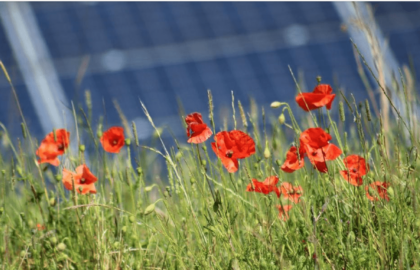
According to the first national survey of wildlife in UK solar farms, these renewable energy installations provide a habitat for several species in decline, revealing solar farms’ unexpected role in wildlife preservation, particularly those intentionally managed with conservation in mind.
In a significant find, linnets, a bird species on the UK’s red list of conservation concerns, were observed in over half of the 37 solar farms examined in the initial survey.
Yellowhammers and skylarks were also spotted on approximately half of the sites, sharing the same conservation status. Birds listed as amber by the British Trust for Ornithology, including grey wagtails, whitethroats, wrens, and willow warblers, were among those noted by the ecologists.
Increased number of pollinators
In addition, the survey suggests that neighbouring agricultural fields could benefit from an increased number of pollinators residing around ground-mounted photovoltaic panels.
Hollie Blaydes, the PhD student leading the research, said: “It is very clear that solar farms can be wildlife havens.”
She added, “About half of the solar farms surveyed are managed with conservation specifically in mind, such as limiting grazing to only certain times of the year and reducing herbicide use. It’s on these where wildlife can really thrive and benefit from the habitats created. These findings and the net gain regime could help tilt the industry further towards improving biodiversity.”
Besides birds, mammals like the brown hare were identified in a quarter of the sites surveyed. The report states: “It appears that solar farms offer ideal habitats for this declining species of conservation concern.”
Smaller, less visible mammals like voles and mice were also presumed to be present but remained undetected.
Solar farms supporting wildlife
The report further elucidates, “The low intensity of management on solar farms, as well as the range of habitats present, can support a variety of invertebrate species,” emphasising the importance of solar farms in supporting these organisms that many other species depend on, either for food or pollination.
One of the intriguing findings of the study pertains to the diversity and abundance of invertebrates, which were strongly associated with management being more focused on wildlife.
Solar farms with higher nectar productivity were discovered to host significantly more butterflies and bees. As such, solar farms are suggested to act as a “longer-term resource supporting larger numbers of local pollinators which may, in turn, enhance pollination services to nearby crops,” according to the report.
The encouraging findings of this survey make a compelling case for more asset owners to embrace a standardised approach to monitoring ecology on solar farms.
These renewable energy installations contribute to our climate goals and serve as potential lifelines for biodiversity, offering a ray of hope for threatened species.
As Rachel Hayes, consents and ESG policy manager at Solar Energy UK, said: “Wildlife can benefit hugely from developing solar farms, providing a variety of habitats and raising the numbers of some of our most threatened species while pushing us forward towards net zero.”